
Izatha prasophyta is a moth of the family Oecophoridae. It is endemic to New Zealand, where it is known from the North Island, except Hawkes Bay or the Wairarapa. Larvae likely feed on rotting wood although larvae of this species have been reared on the fruiting body of the bracket fungus Bjerkandera adusta. Adults are on the wing from November to February.

Trachypepla semilauta is a moth of the family Oecophoridae and was first described by Alfred Philpott in 1918. It is endemic to New Zealand and has been collected in Southland. This species inhabits southern beech forest on the side of mountains. Adults are on the wing in January.
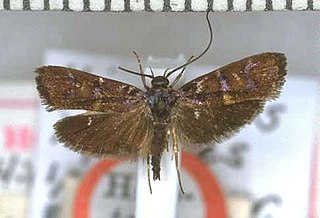
Hierodoris iophanes is a moth of the family Oecophoridae. It was described by Edward Meyrick in 1912. This species can be distinguished from others in its genus by the purple metallic colouration as well as the blue-white mark on its forewings. It is endemic to New Zealand, where it has been recorded from Auckland to Southland. This species inhabits native forest or scrub, with the adults preferring open glades. They are known to be on the wing from November until February and fly during daylight hours, being active on hot sunny days. Larvae feed on the interior of twigs of Prumnopitys ferruginea. The twigs had evidence of oviposition scars of cicadas and the larvae were collected in October after reddish-brown frass indicated their location within the twigs.
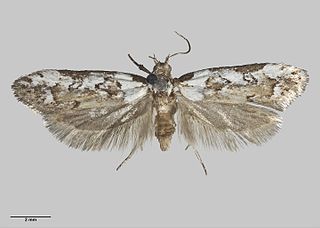
Trachypepla festiva is a moth of the family Oecophoridae and was first described by Alfred Philpott in 1930. It is endemic to New Zealand and has been collected in the northern parts of the North Island.

Hierodoris insignis is a species of moth in the family Gelechiidae. It is endemic to New Zealand and has been found in the Nelson/Tasman districts. The larvae are leaf miners and are hosted by Celmisia species. Adults are on the wing in January. It is likely that this species belongs to another genus and as such this species is also known as Hierodoris (s.l.) insignis or 'Hierodoris' insignis.

Tingena chloritis is a species of moth in the family Oecophoridae. It is endemic to New Zealand and has been found in the South Island. Larvae of this species feed on leaf litter. The adults of this species are light flyers and are attracted to light.

Tingena compsogramma is a species of moth in the family Oecophoridae. It is endemic to New Zealand and has been observed in the North and South Islands. This species inhabits native forest and adults are on the win from December until March.
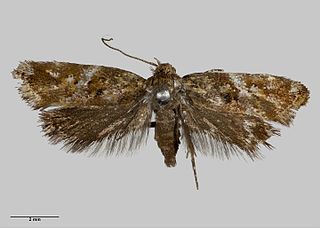
Tingena eumenopa is a species of moth in the family Oecophoridae. It is endemic to New Zealand and found in the North and South Islands. The adults have been found amongst tree ferns and are on the wing in December.

Tingena falsiloqua is a species of moth in the family Oecophoridae. It is endemic to New Zealand and has been collected in the North Island. This species frequents subalpine native forest.

Tingena seclusa is a species of moth in the family Oecophoridae. It is endemic to New Zealand and has been observed in the Canterbury and Otago regions. The larvae of this species are litter leaf feeders and the adults of this species are on the wing from December to February.
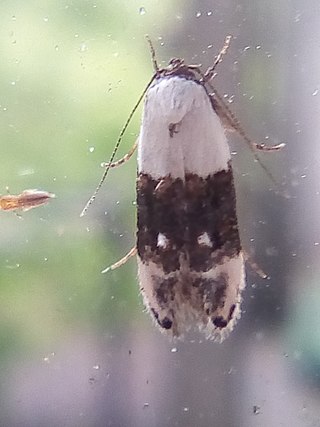
Trachypepla amphileuca is a species of moth in the family Oecophoridae. It is endemic to New Zealand and has been observed in the North Island. This species inhabits native forest. Adults are on the wing from October to January and are attracted to light. The wing pattern of T. amphileuca is said to imitate the appearance of bird droppings.
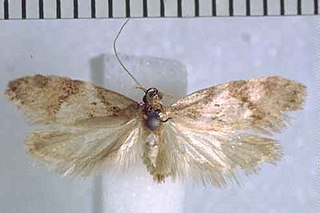
Trachypepla angularis is a species of moth in the family Oecophoridae. It is endemic to New Zealand and has been collected at Lake Rotoroa in the Nelson Lakes National Park in January. This species inhabits mixed native forest.
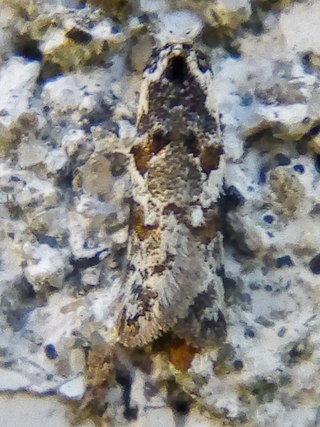
Trachypepla galaxias is a moth of the family Oecophoridae first described by Edward Meyrick in 1883. It is endemic to New Zealand and can be found throughout the country. This species inhabits native forest. The life history of this species is currently unknown. Adults are on the wing from October to February, are nocturnal and are attracted to light.

Trachypepla importuna is a moth of the family Oecophoridae first described by Edward Meyrick in 1914. It is endemic to New Zealand. Adults have been collected in the North Island in January but the species is regarded as being poorly known.

Trachypepla ingenua is a moth of the family Oecophoridae first described by Edward Meyrick in 1911. It is endemic to New Zealand and has been collected in both the North and South Islands. This species is one of the larger in the genus Trachypepla and the colouration of the adults imitates bird droppings. The preferred habitat of T. ingenua is native forest and adults are on the wing from December to February.

Trachypepla leucoplanetis is a moth of the family Oecophoridae first described by Edward Meyrick in 1883. It is endemic to New Zealand and has been collected in both the North and South Islands. It is the smallest moth species in the genus Trachypepla and the patterns on the forewings of adults are variable in appearance. It inhabits native forest and bush and the larvae feed on leaf litter. Adults are on the wing from October until February. T. leucoplanetis is regarded as being rarely observed and has been collected via the beating of foliage.

Trachypepla lichenodes is a moth of the family Oecophoridae first described by Edward Meyrick in 1883. It is endemic to New Zealand and has been found in both the North and South Islands. It inhabits native forest and adults of this species are on the wing from November to January. The adult moths are similarly coloured to native lichen species however this colouration is variable in the extent and depth on the forewings.

Trachypepla photinella is a moth of the family Oecophoridae first described by Edward Meyrick in 1883. It is endemic to New Zealand and has been collected in Wellington, Wainuiomata, D'Urville Island and Christchurch. The preferred habitat of this species is native forest and adults are on the wing from December until February.

Trachypepla protochlora is a moth of the family Oecophoridae first described by Edward Meyrick in 1883. It is endemic to New Zealand and is found in both the North and South Islands. The preferred habitat of this species is native forest and adults are on the wing from October until February. Adults can be variable in their green shaded colour as well as in the intensity of markings on their forewings. The greenish ground colouration of this moth ensures they are well camouflaged when at rest on green mosses and lichens.

Trachypepla spartodeta is a moth of the family Oecophoridae first described by Edward Meyrick in 1883. It is endemic to New Zealand and has been collected in both the North and South Islands. This species inhabits native forest and adults are on the wing from November to January.





















